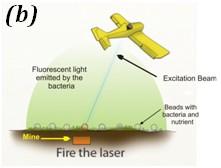Standoff Detection of Explosives and Buried Landmines Using Fluorescent Bacterial Sensor Cells
We develop a method for remote sensing of buried landmines and concealed explosive charges. The scheme is based on fluorescent bacterial biosensors. These are genetically engineered bacteria that produce Green Fluorescent Protein (GFP) in response to exposure to explosives. Future employment of this method is illustrated in Figure 1.
 |
 |
Figure 1: (a) Polymer beads encapsulating the bacteria and their nutrient are sprayed over the suspected area; (b) The area is scanned by the excitation beam while collecting the fluorescent signal.
The method employs a heterodyne detection technique that identifies the fluorescent signal by phase locking to the excitation modulation, which yields high signal to noise ratio while ignoring the background illumination.
This method enables direct access to the suspected area without endangering the operating personnel and the equipment. It can be employed in a variety of different application for scanning large outdoor environment either from the air or from a vehicle that carries the apparatus.

Figure 2: Excitation and detection system.
More information can be found in [REF13].
The project is done in collaboration with Prof. Shimshon Belkin’s group at the Institute of Life Sciences, and Prof. Amos Nussinovitch’s group at the Faculty of Agriculture.

